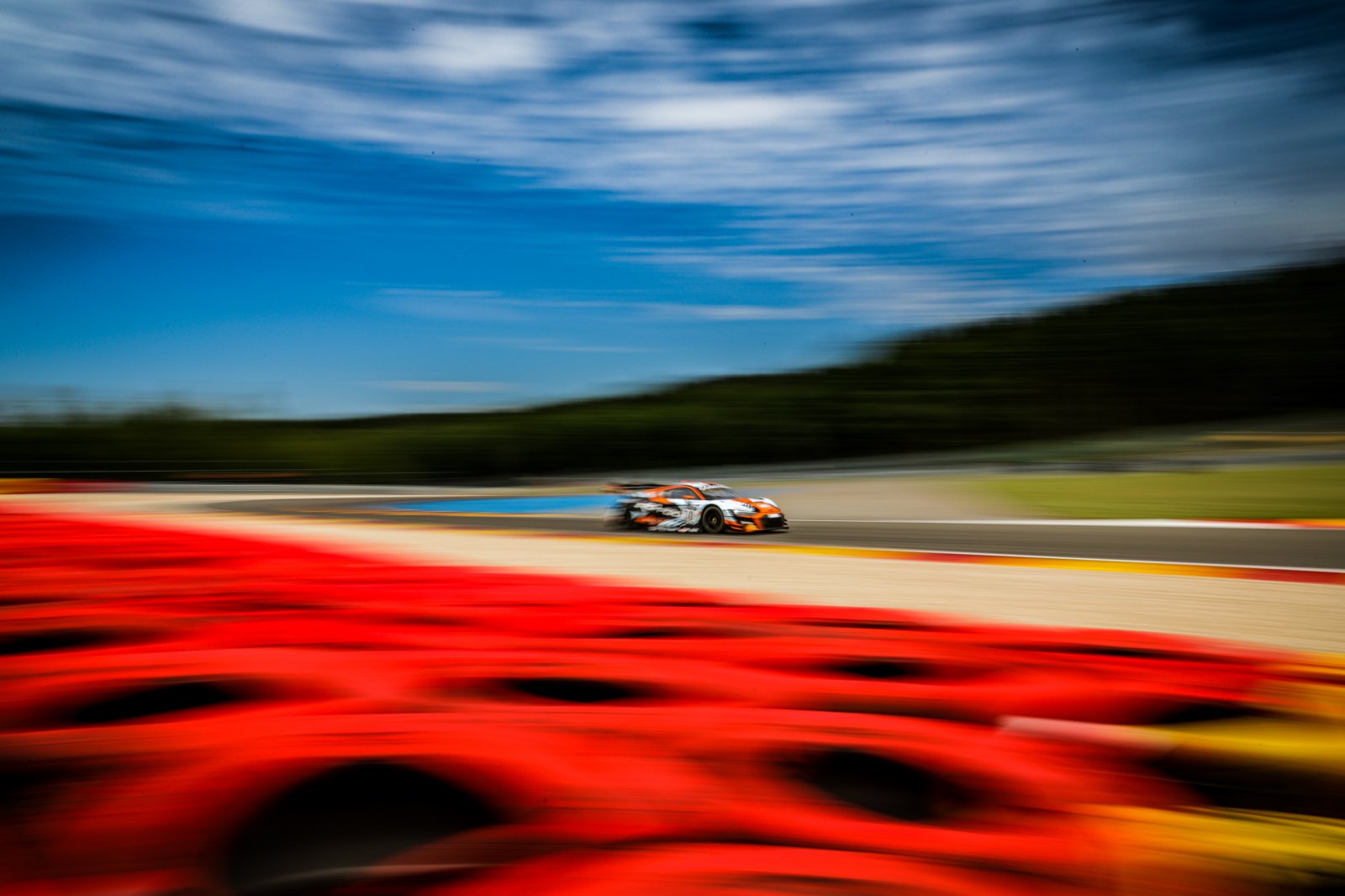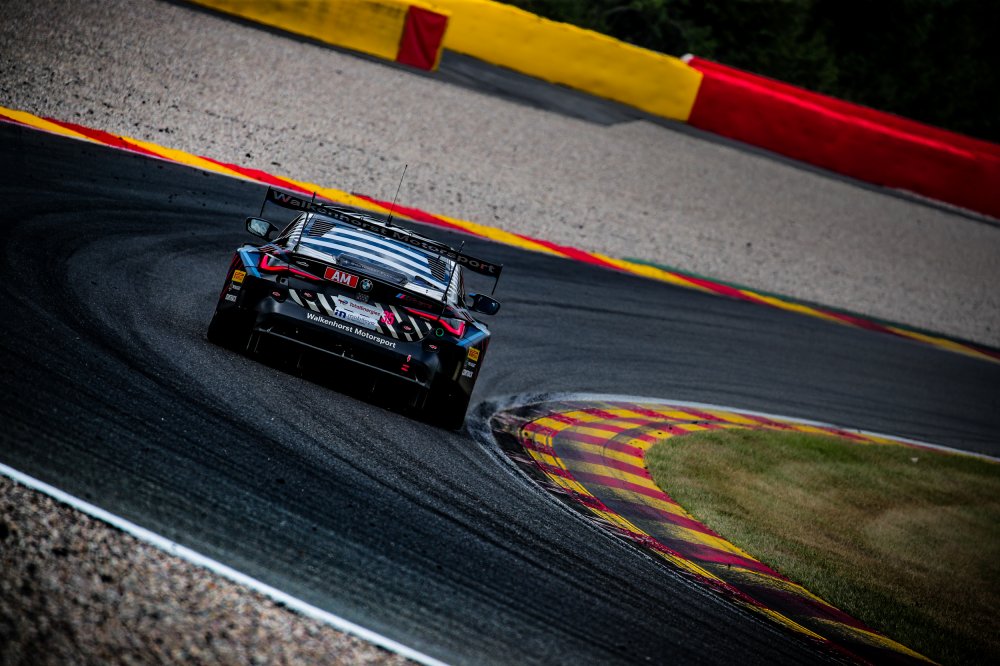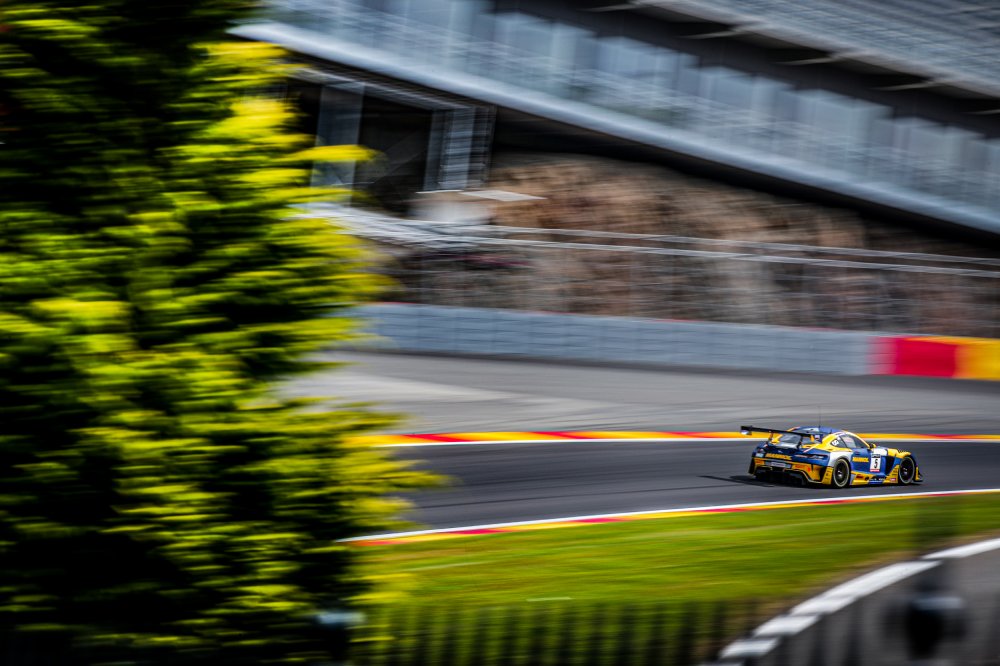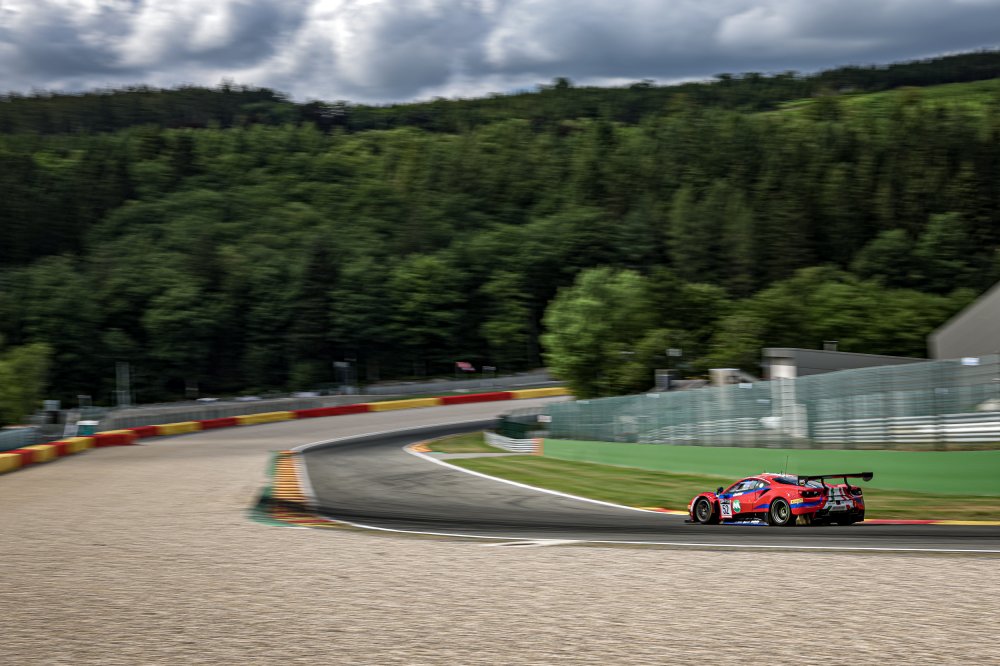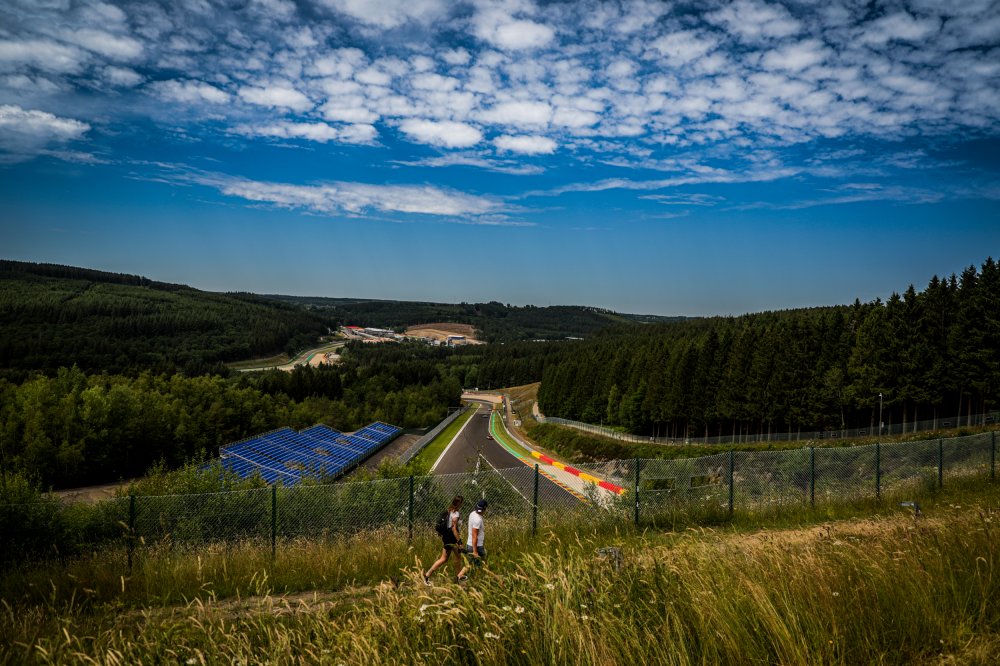- 66-car field spread across five classes, including new Gold Cup and record Silver Cup grid
- Track action begins on Tuesday 26 July, culminates with race start at 16:45 on Saturday 30 July
- Big points haul on offer with extra chances to score at six and 12-hour marks
This 2022 TotalEnergies 24 Hours of Spa is just around the corner – and it’s going to be big. Nine prestigious automotive brands will be represented on a stacked 66-car grid, a number topped only once during the past two decades.
As such we should see plenty of action, though it will also mean there is a lot to keep track of. Whether you're a first timer, a GT aficionado or a fan since the touring car days, this race can be complicated. After all, there are five classes, each with different rules regarding drivers, and that's to say nothing of maximum stint lengths and mandatory pit stops.
But fear not: we have assembled the most important information that you need to know ahead of this year's TotalEnergies 24 Hours of Spa.
Categories
One of Spa's unique features is that its class structure is based solely on driver grading. So, while there will be five categories on-track this year, every car conforms to GT3 regulations. Crews competing in Pro are only eligible for the overall result, while those in the Silver Cup, Gold Cup, Pro-Am and Bronze Cup also compete for class honours.
First, it's worth mentioning a few rules that are applicable to all classes. Over the full duration of the race, no driver can spend more than 14 hours behind the wheel. The maximum continuous driving time is three hours and 15 minutes – that's three full stints – after which there is a mandatory one-hour rest.
The Pro category remains the biggest in 2022, with 23 cars committed. Each crew is limited to three drivers, but there are no additional rules on driving time nor on categorisation. Barring a major upset, this category will fill the overall podium on Sunday afternoon, as it has every year since the current class structure was introduced in 2011.
Introduced to the event in 2018, the Silver Cup is beginning to challenge Pro in terms of numbers. A record 19 cars are confirmed this year, including some very strong line-ups that could challenge for the overall top-10. Each crew consists of up to four Silver-graded drivers, with no extra limits placed on driving time. The fourth driver is optional, with five of this year's field electing to maintain their full-season Fanatec Endurance crews.
The Gold Cup is a new addition for 2022 and has drawn an impressive 14-car grid. Full-season line-ups consist of one professional (either Gold or Platinum) alongside a Silver and a Bronze, while an additional Silver can be added for the 24 Hours. In terms of driving time, the Bronze must be behind the wheel for at least four hours, including one hour in the first six. The pro driver will be limited to eight hours in total.
In Pro-Am, a maximum line-up of two Platinum and two Bronze-graded drivers is allowed. In terms of driving time, this is the most complex: a Bronze must be behind the wheel for a minimum of eight hours during the race, and for at least one hour during each six-hour period. This time can be shared between two the Bronze drivers.
The Bronze Cup is a new name for 2022, though it is identical to the old Am Cup class. Crews may consist of up to four Bronze drivers, or three Bronze and one Silver. The Silver can only be behind the wheel for a total of six hours during the race, and for a maximum of two hours in each six-hour period. There are two Am crews confirmed for 2021, both of which have elected to run the optional Silver driver.
The Format
The 2022 TotalEnergies 24 Hours of Spa will be the third round of the Fanatec GT World Challenge Europe Powered by AWS Endurance Cup, as well as the second stop on the Intercontinental GT Challenge Powered by Pirelli tour following the LIQUI MOLY Bathurst 12 Hour. Track activity begins at 14:55 on Tuesday with the Bronze Test, which runs for three hours and is open to all Bronze-graded competitors, as well as any Silver drivers competing outside the Pro category who have never previously raced at Spa.
Wednesday is reserved for off-track activities, notably the parade from the track to Spa town centre, which returns in 2022 following a two-year hiatus. The action really steps up a gear on Thursday, which begins with a 90-minute Free Practice at 10:50 followed by a one-hour Pre-Qualifying at 16:15. Both are primarily about preparation, while Pre-Qualifying can also be used to set the grid if Qualifying can’t take place.
All being well, we move on to Qualifying. With a scheduled start time of 20:40, the session will begin in daylight and end shortly after the sun has set on Spa-Francorchamps. It follows the usual Fanatec Endurance format, though there are four 15-minute sessions instead of three. One driver from each car contests a session, with three-driver crews skipping Q1 and the average time establishing the order.
The fastest 20 book a spot in Friday's Super Pole shootout, while positions 21 through 66 are locked in barring any penalties. At this point we are likely to know who is on pole in the Gold Cup, Pro-Am and Bronze Cup classes; we might also have our Silver Cup pole-sitter, though it is entirely possible that more than one Silver crew will progress to Super Pole.
Meanwhile, attention begins to shift to the race with a 90-minute Night Practice that runs from 22:20 until shortly before midnight. All drivers must complete at least two flying laps (from timing line to timing line) during this session to meet their night-driving criteria.
Friday is all about Super Pole. First, there is a 20-minute Warm-Up at 18:20, which is open to all competitors. For those contesting Super Pole, it's an opportunity for a quick shakedown; for the remainder of the field, this is the last chance to run before the main event.
At 19:00 the Super Pole battle begins. Each crew nominates one driver, who has two flying laps to set their best time. They run in reverse order and at one-minute intervals, meaning the excitement builds throughout the session. Mercedes-AMG has clinched pole for the past three editions and will be gunning for a fourth in succession this year, something that has not been achieved since the move to GT rules in 2001.
With the full 66-car grid set, all that remains is the big event. The action begins at 16:45 on Saturday afternoon when the TotalEnergies 24 Hours of Spa sets off on its 74th edition. After a full day and night of racing, this year’s winners will be crowned on Sunday afternoon.
Stints, Stops & Tyres
During the race, you will often hear commentators talk about a stint. Put simply, this is the continuous time that a car spends on-track: the clock begins upon leaving the pits and is reset when the car returns. The maximum stint length at Spa is 65 minutes, unless a full-course yellow or safety car period is in operation when the stint finishes. In this case, an additional five minutes is allowed to return to the pits at a slower speed.
Pit stops are crucial in endurance racing and there will be hundreds performed throughout the 24 Hours. For standard stops, there is a minimum refuelling time during which the car must remain connected to the rig. Tyre and driver changes can take place during refuelling, but they are optional. A one-second tolerance on pit stop time is permitted on four occasions during the course of the race.
Short refuelling stops are also allowed. For these, a maximum refuelling time will be determined and can differ between brands. As such some cars may need to complete a ‘stop and hold’ to ensure that they are stationary for the same amount of time. There is no tolerance on short pit stops, so it is essential that teams get them right.
Additionally, each car must perform a technical pit stop, lasting at least four minutes from pit-in to pit-out. This is to allow teams to change items such as brake pads, a task that can be performed much quicker on some cars than others. The technical pit stop can be taken at any point between the start of the 12th hour and end of the 22nd hour.
As sole tyre supplier to a field of 66 cars, the TotalEnergies 24 Hours of Spa is a huge undertaking for Pirelli. The Italian company produces up to 17,000 tyres for the race, sending around 35 trucks and a huge army of support staff to the Ardennes.
They provide each car with a maximum of 30 sets of dry tyres, which must be used from free practice onwards. Two sets from the official test day can be carried over as part of the 30-set allocation, while an additional set is authorised for the cars taking part in Super Pole. These can’t be used during the race, so there's no excuse not to push them to the absolute limit.
Of course, we know just how big a part the weather can play at Spa. Rain is a possibility and can shape the outcome of the race, just as we saw during the closing stages of last year's edition. The good news here is that there is no limit on the use of Pirelli's wet compound tyre, ensuring that all cars can be on the correct rubber for the conditions.
Points & Prizes
With extra points on offer, the TotalEnergies 24 Hours of Spa can make or break a championship bid. In a change for 2022, the top-three qualifiers in Friday night’s Super Pole will now score points on a 3-2-1 basis, while each class pole-sitter will pick up the usual one-point bonus. The Fanatec Esports GT Pro Series also awards overall and Silver Cup teams’ championships points on a 5-4-3-2-1 basis, with a one-hour Assetto Corsa Competizione race on Friday afternoon deciding the scores.
Let's move on to the race itself. Points are awarded to the top-nine runners in each category after six and 12 hours on a basis of 12-9-7-6-5-4-3-2-1. As ever, full points are awarded to the top-10 at the chequered flag using the standard 25-18-15 format. It is important to note that any team that has not entered one of this season's Fanatec GT World Challenge Europe Powered by AWS races is ineligible to earn points, but their drivers can score.
Spa will also represent the second round of the Intercontinental GT Challenge Powered by Pirelli campaign. Competing manufacturers may nominate up to four cars, a maximum of three from the Pro category, which can score points towards the 2022 championship. Mercedes-AMG leads the standings after SunEnergy 1 Racing claimed victory in the season-opening LIQUI MOLY Bathurst 12 Hours. All four of its drivers – Kenny Habul, Jules Gounon, Martin Konrad and Luca Stolz – will compete at Spa, albeit with different teams.
The event is also the biggest points-scoring opportunity for the global Fanatec GT World Challenge Powered by AWS. All seven eligible brands will be represented, with points awarded at the end of the race in each class and multiplied by the number of entries. As it stands, Mercedes-AMG leads the way from Audi Sport.
Last but by no means least, the Coupe du Roi rewards the manufacturer that scores the best result across the classes, with points awarded per car at six, 12 and 24 hours. Last year, Ferrari took an empathic victory thanks to its overall triumph with Iron Lynx and a Pro-Am class win for the AF Corse squad.
With this information at hand, you are fully up to speed for the 2022 TotalEnergies 24 Hours of Spa. As ever, the event will enjoy extensive online coverage, including English, German, French and Italian commentary streams on the GT World YouTube channel. The live action begins with Thursday Pre-Qualifying session and includes every second of racing action from this year’s 74th edition.

